During repair work, it is necessary to determine where the electrical cable lies in the wall so as not to get an electric shock when drilling or damage the wiring, which may still be useful. This will help the device for finding hidden wiring. You can buy it in a store or assemble it yourself - this requires minimal knowledge of electrical engineering.
- How to choose a hidden wiring detector
- Wiring and metal detectors - purpose and types
- Detector characteristics
- How to check a hidden wiring alarm
- Procedure for finding hidden wiring
- DIY indicator
- How to make a DIY wiring detector
- How to replace the transaction tracking indicator
- Functional features of signaling devices
- Which device is better - imported or domestic
How to choose a hidden wiring detector
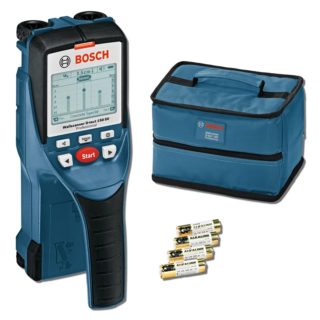
The wire detector has different characteristics. The main indicator is the scanning depth. Since the cable is rarely laid deep, the optimal indicator is 5 - 6 cm.
What else is the device capable of doing:
- identify empty spaces in the walls;
- react to wire damage;
- identify materials other than metal.
The signal or indication when the wiring is found can be color or sound. At the same time, the device shows at what depth the cable is. There are devices with two different indications that confirm each other.
The most convenient is a wiring detector with an LCD display, but it will cost more. If you buy a device for the first time, it is better to take the more expensive one. Some masters get used to simpler indications, so they are well guided by them.
When buying, it is recommended to test the detector and ask the seller for help in understanding the features of the operation. They mainly test the depth of the cable.
Wiring and metal detectors - purpose and types

In panel and brick houses, power cables are laid using the method of shtrobnaya and the walls are plastered before finishing. For redevelopment, arrangement of doors in a new place, when demolishing partitions, there is a risk of damaging the styling, after which it will need to be completely replaced. Before starting work, it is advisable to search for where exactly the cable is located in the wall in order to bypass it when drilling and dismantling the walls.
It happens that during the shrinkage of new buildings, the walls crack, and the electrical communications laid in it are damaged. In order not to completely break the walls, you can buy a device that is able to detect damage in the circuit and start working in the place where it is needed.
Even simple actions - drilling holes for a shelf or a lamp, installing an outlet - require a preliminary check if there is a cable nearby that can be damaged by a drill, in addition to get an electric shock.
With a wiring detector in the wall, they also check the correct connection of the electricity meters, determine the phase wire, ungrounded electrical devices, and the serviceability of the fuses.
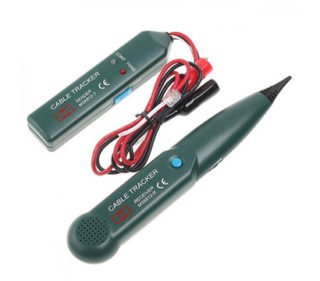
There are several types of devices:
- Reactive to static electricity. These detectors have many functions, although most of them may not be useful. Their disadvantage is that the cable disconnected from the power supply will not be detected.
- Devices of electromagnetic action. Accurate devices, but do not identify cable with less than 1 kilowatt load.
- Metal detectors. In addition to wiring, they are able to find nails and other metal objects in the walls.This can both interfere and help in work - it depends on the goal. A de-energized wire, inaccessible for the first two types, the metal detector will find quickly.
Combined metal alarms have more functions and are therefore more expensive. They can be used to detect non-ferrous metals or very deeply embedded wiring. Inexpensive devices are usually designed to do one thing.
Detector characteristics
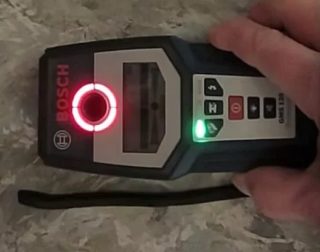
Each device for detecting hidden electrical wiring has its own pros and cons. For example, electrostatic ones are able to locate wires that are energized, even if no current is passed through them. They also react to breaks in the circuit. The disadvantage of the device is its sensitivity to electrical devices - routers, microwave ovens, a computer and even a mobile phone. Walls that are damp for any reason also interfere with the operation of the device.
Electromagnetic wiring indicators very accurately, down to a millimeter determine its location in the wall, but do not catch low-power cables with which lighting devices are equipped - lamps or chandeliers. In this case, you cannot use cheap devices, you will have to buy an expensive detector, for example, from Bosch, which is the best of its kind.
Metal detectors are more often used to clarify data from other devices, for example, of an electromagnetic type, if the signal is weak due to insufficient electrical load.
Distinguish between professional and household appliances. A professional hidden wiring detector with many functions and high accuracy of cable location costs in the region of $ 500 - $ 600. Such a device has several simultaneous indications - color, sound, graphic.
In appearance, they are distinguished by flat detectors and in the form of a cylinder. The latter are usually cheap, but are suitable for identifying extremely shallow wiring. If the owner knows how deep the cable was laid during the last repair, a cylinder detector is sufficient. If the apartment is new and there is no information about the electrical part, it is better to get a more functional device.
How to check a hidden wiring alarm
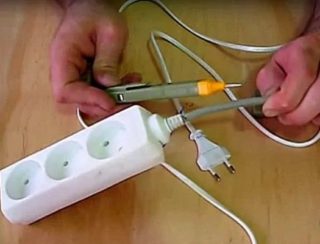
It is necessary to check the device in the store. At small outlets, vendors may discourage testing, citing the lack of working electrical devices. This means that the detector may be of poor quality.
The verification procedure consists of several stages:
- Switch on the device and bring it to any visible wiring.
- Try to pick up the signal from the same cable, but at the distance specified by the manufacturer.
- Turn off the device that consumes electricity and try to detect it without voltage. This is necessary if the seller does not know all the functions of the detector.
- Cover the device with something so that the detector can identify it through the obstacle.
If all parameters correspond to those described in the instructions, the signaling device can be purchased.
Procedure for finding hidden wiring
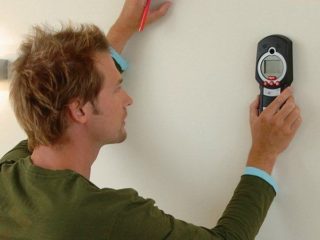
Before using the wiring detector, it must be configured (calibrated). The description and sequence of actions is indicated in the attached instructions. After adjustment, the device is brought to the place where there is definitely a cable. If the device signals with sound or light, you can start working.
A common way of laying the cable - vertically and horizontally - can help. Most likely, the wire will go up from the outlet, and most craftsmen lay the wires horizontally at a distance of 15 cm from the floor or ceiling.
The search must be carried out on a dry surface with the wiring turned on, otherwise the determination errors will be large.
When a professional detector from Bosch is operating, when a hidden wire is detected, the indicator light turns red, and the located graphic moving marks on the LCD screen converge to the center, accurately indicating its location. Guided by the readings of the sensor, you can make a mark with a pencil.
DIY indicator
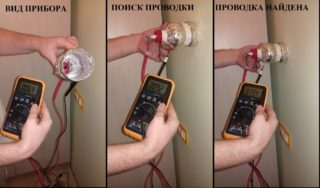
An amateur device can be made with your own hands, having at hand several options for schemes and improvised materials - aluminum tape or copper wire as an antenna, a frame from a colored marker or a small lamp for the case. The circuits use resistors or field effect transistors.
A more accurate instrument that only responds to 50 Hz can be made using a microcontroller. This type of alarm will only be triggered if it finds the wiring and the magnetic field above it. The LED lamp can be used as an indicator, and a piezo emitter that starts to emit crackles is also suitable.
It is possible to assemble a professional-grade wiring detector at home, but this requires serious knowledge in the field of electrical engineering and time.
How to make a DIY wiring detector
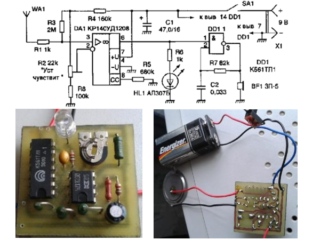
To make a home contactless wiring identifier, you will need:
- 3 bipolar transistors NPN, C945 - can be taken from an unnecessary board;
- red LED;
- resistance resistor 1kOm;
- copper wire 0.5 mm insulated;
- connector with battery krone.
Assembly order:
- Cut off 30 cm of copper wire, wind it around a toothpick - this will be the antenna.
- Connect all elements by soldering, starting from the copper antenna: transistors to each other, resistor, LED to transistors, the first tap from the connector to the resistor, the second tap to the transistor.
- When the circuit is ready, the crown battery is taken and connected to the connector.
You can test a non-contact voltage detector by plugging any electrical device into the network, for example, a hair dryer or a drill. If you bring the copper antenna of the battery-connected detector to the wire, the LED will light up. The farther from the wire, the weaker the light from the lamp will be.
As the trial test shows, an amateur device is enough to detect the wiring that is shallow in the wall.
When testing or verification is complete, the circuit is disconnected from the battery.
How to replace the transaction tracking indicator
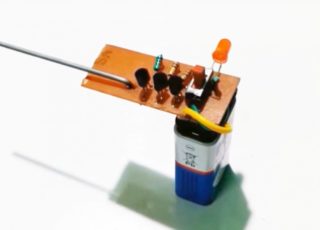
There are many other ways in which the location of the wire is determined. The simplest one is visual. If you know how electricians lay the cable, you can predict in advance where it is located. The most likely location is horizontal to the floor and ceiling at a distance of 10-15 cm. Vertical wires go up from all sockets and switches.
The principle of operation of the detector is similar to that of a radio receiver. With its help, you can find both the wiring itself and its breaks. The difference will be audible. To do this, you need to turn on the radio and tune it to the transmission wave. Next, lead close to the wall on which the wiring is supposedly located. The receiver lamp above it will light up.
Magnetic waves emanating from live cables can be detected using an app on a smartphone. Special sensors will pick up the signal and send it to the monitor.
If there is an old radio tape recorder with a microphone, it can also be used for searching, but there may be errors of up to 15 cm, so it is better to use several methods at once to narrow the search radius. The microphone usually pops when approaching a wire. Hearing aids or multimeters work in a similar way.
Functional features of signaling devices
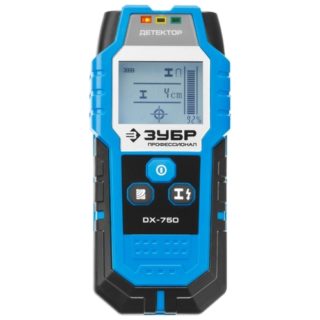
Most of the models of signaling devices are produced in combination. They are more likely to determine the location of the cable, as well as metal objects, as well as wood and plastic. The main goal is achieved - the device confirms the presence of a live cable and its depth, as well as the location line to the millimeter.
The main functions that are inherent in high-quality combination models include:
- The devices are capable of operating at temperatures from minus 10 to plus 50 degrees.
- Determine the polarity in DC circuits from 6 to 36 V.
- They catch magnetic radiation with a power of more than 0.5 MW per cm.
- Non-contact models detect alternating voltages from 70 to 600 V.
- Household appliances are capable of detecting metal objects and cables at a depth of 2 to 6 cm.
- Determine the integrity of the resistance in the range from 0 to 50 mΩ.
- They transmit information to the screen or in the form of sound, light indicators. In high-quality models, there are several types of indication at once.
- Almost all detectors operate on AA batteries.
A manufacturing defect or a fake of a well-known brand of devices may not correspond to the description, for example, a comparative analysis of the original Bosch device and the Chinese expensive M120 device, which was positioned as a complete analogue of the German brand, was carried out. As a result of testing, significant shortcomings were revealed - the Chinese counterpart did not cope with the search in the electromagnetic search mode, although it proved to be good in the metal detector mode.
Which device is better - imported or domestic

To decide on the choice of a signaling device, you need to know the nuances: each country produces devices designed for wiring and the rules for its installation on the territory of its state. There is a risk that imported equipment will not provide reliable information.
It is possible to order a batch of equipment, which will be made specifically for the Russian cable and its features. In this case, it would be better to ask the store whether the device is suitable for our electrical networks or is it better to buy a domestic one. It is not a good option to buy the device abroad. In this case, it will definitely turn out to be unusable, and it will not work to return it.
The quality of Russian electrical appliances is quite high, so they are often used by professional electricians. There are cheaper devices for household needs, which also work well, but preliminary settings are required.








